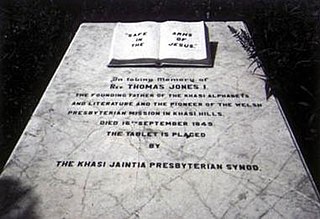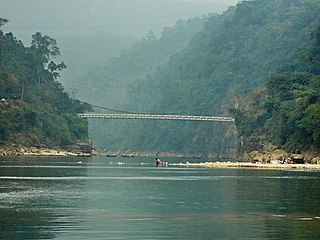
Microbiotheria is an australidelphian marsupial order that encompasses two families, Microbiotheriidae and Woodburnodontidae, and is represented by only one extant species, the monito del monte, and a number of extinct species known from fossils in South America, Western Antarctica, and northeastern Australia.

Microbiotheriidae is a family of australidelphian marsupials represented by only one extant species, the monito del monte, and a number of extinct species known from fossils in South America, Western Antarctica, and northeastern Australia.

The Khasi Hills are a low mountain formation on the Shillong Plateau in the Meghalaya state of India. The Khasi Hills are part of the Garo-Khasi-Jaintia range and connect with the Purvanchal Range and the larger Patkai Range further east. The Khasi Hills, and the whole Garo-Khasi-Jaintia range, are in the Meghalaya subtropical forests ecoregion.
The Khasia, or Khasiya is a clan (Gotra) of the Koli caste found in the Indian state of Gujarat. The Mahuva was the stronghold or controlled by Khasia Kolis but they were defeated by the Thakur Wakhatsinhji of Bhavnagar State and their controlled Territories of Mahuva, Kundla, Rajula, Gadhada and Botad. Khasiya Kolis were pirates in Gujarat ocean and lived by piracy.

Lohaghat is a town and a nagar palika in Champawat district in the Indian state of Uttarakhand. Lohaghat is also famous for its various cultural events like Holi Rang Mahotsav, Devidhar Mela ,etc. Most special thing regarding Lohaghat is the Ramleela of Lohaghat which is one of the oldest Ramleela of Kumaoun Division.

The Dongkha la or Donkia Pass(Chinese: 东卡拉山口) is a high mountain pass in the Himalaya connecting Sikkim in India with Tibet.

Nigel Jenkins was an Anglo-Welsh poet. He was an editor, journalist, psychogeographer, broadcaster and writer of creative non-fiction, as well as being a lecturer at Swansea University and director of the creative writing programme there.

Thomas Jones was a Welsh Christian missionary, who worked among the Khasi people of Meghalaya and Assam in India and of Bangladesh. He recorded the Khasi language in Roman script, and the inscription on his gravestone calls him "The founding father of the Khasi alphabet and literature".

Chrysozephyrus khasia, the tailless metallic green hairstreak, is a small butterfly found in India that belongs to the lycaenids or blues family.

Jaflong is a hill station and tourist destination in the Division of Sylhet, Bangladesh. It is located in Gowainghat Upazila of Sylhet District and situated at the border between Bangladesh and the Indian state of Meghalaya, overshadowed by subtropical mountains and rainforests. It is known for its stone collections and is home of the Khasi tribe.
Jethwa is a clan of Rajputs and Koli castes of Gujarat. Jethwa surname is also found among Darji, Mistris of Kutch, and Gurjar Kshatriya Kadias castes of Gujarat.
Abraxas symmetrica is a species of moth belonging to the family Geometridae. It was described by Warren in 1894. It is known from the Khasia Hills in India.
Abraxas disrupta is a species of moth belonging to the family Geometridae. It was described by Warren in 1894. It is known from Khasia Hills in India.
Bhadrod is a village in Mahuva Taluka of Bhavnagar district, Gujarat, India. It is situated four miles north east of Mahuva and fifty-one miles south-west of Bhavnagar. It is built on the western bank of the Bhadrodi river.
Juna Padar was a petty princely state in the Gohelwar prant of Kathiawar. It consisted of a single village ruled by Khasia Koli chieftains.

Gwalia in Khasia is a 1995 travelogue by Welsh author Nigel Jenkins. Published by Gomer, it won the Wales Book of the Year in 1996.
Terellia tribulicola is a species of tephritid or fruit flies in the genus Terellia of the family Tephritidae.
Mayulestes is a genus of carnivorous metatherian that lived in what is now Tiupampa, Bolivia in the early Paleocene. It shared its habitat with fellow sparassodont Pucadelphys, and a microbiotherid marsupial, Khasia.
Lasubon Canyon is an ancient canyon located about 25 km from Srimangal of Moulvibazar District. This canyon is situated in a densely forested hilly area of Sindurkhan Union, bordering the Indian state of Tripura. The word Lasubon in Khasi language means mountain flower or wildflower. Officially known as Lasubon canyon, it is widely referred to as Srimangal canyon by the local people. There are many small and big rocky ridges or jhiri in this canyon. It is known for the discovery of three major canyons in this area. These are popularly known as Krem Clue, Krem Kerri and Krem Ulka in the local Khasi language.
U Larsing, also known as Larsing Khongwir, was an Evangelist missionary who practiced in the area of the Khasi Hills, Meghalaya, India during the late 1850s and early 1860s. Additionally, he was the first Khasi Missionary to visit and preach in England and Wales during the early 1860s.








